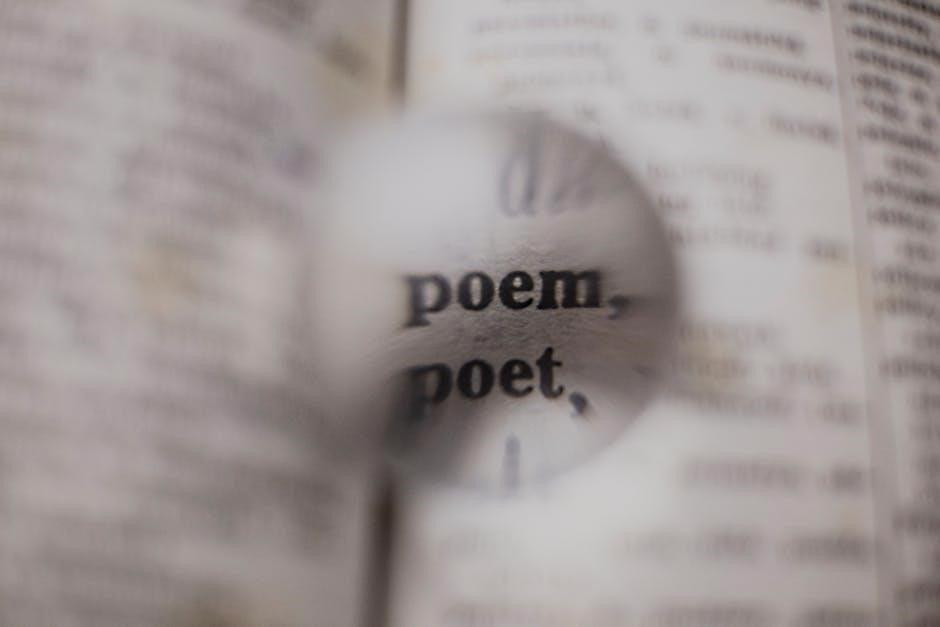
The Highwayman‚ a classic narrative poem by Alfred Noyes‚ tells a tale of doomed love and betrayal set in 18th-century England; Its vivid imagery and rhythmic style captivate readers‚ while its PDF versions enhance accessibility for modern study and appreciation.
Overview of the Poem
The Highwayman‚ written by Alfred Noyes in 1906‚ is a narrative ballad that tells the tragic tale of a mysterious highwayman and his doomed love for Bess‚ the landlord’s daughter. Set in 18th-century England‚ the poem is renowned for its vivid imagery‚ haunting rhythm‚ and themes of love‚ betrayal‚ and fate. The story unfolds with supernatural elements and atmospheric descriptions‚ culminating in the lovers’ tragic deaths. Its timeless appeal is enhanced by its availability in PDF format‚ making it easily accessible for readers and scholars to explore its literary beauty and emotional depth‚ ensuring its enduring popularity.
Significance of the PDF Format
The PDF format of The Highwayman ensures preservation of its original layout‚ including poetic structure and spacing‚ crucial for understanding the rhythm and meter. This format allows easy accessibility across devices‚ facilitating reading and analysis. PDFs also enable the inclusion of study guides‚ annotations‚ and multimedia enhancements‚ enriching the reader’s experience. The portability and shareability of PDFs make the poem widely available for educational purposes‚ ensuring its timeless appeal. Additionally‚ PDFs often include illustrations and animations‚ further immersing readers in the poem’s atmospheric and tragic narrative‚ making it a preferred choice for both scholars and casual readers seeking a deeper connection to the text.

About the Poet: Alfred Noyes
Alfred Noyes (1880-1958) was a celebrated English poet‚ playwright‚ and essayist‚ best known for his vivid imagery and rhythmic style. Born in Staffordshire‚ he studied at Oxford.
Blind in later life‚ Noyes wrote prolifically‚ with works like The Highwayman showcasing his mastery of narrative poetry. His wife‚ Mary‚ was a significant influence on his writing.
Biographical Background
Alfred Noyes was born in 1880 in Staffordshire‚ England‚ to a family of modest means. His father was a teacher‚ fostering Noyes’ early love for literature. He attended Oxford University‚ where he began writing poetry. Noyes’ first collection‚ The Loom of Years‚ was published in 1904. He gained fame with The Highwayman in 1906‚ solidifying his reputation as a master of narrative verse. Noyes married Mary Wilkinson in 1929‚ and her support was crucial during his later years‚ especially after he lost his sight at age 35.
Inspiration Behind the Poem
Alfred Noyes drew inspiration for The Highwayman from his deep fascination with 18th-century English history and folklore. The poem was influenced by tales of daring highwaymen‚ such as Claude Duval‚ and the romanticized notion of outlaws. Noyes’ personal experiences‚ including his love for storytelling and his interest in the supernatural‚ also shaped the narrative. The poem’s tragic love story reflects universal themes of passion and fate‚ blending historical elements with imaginative flair. Its vivid imagery and rhythmic style were crafted to evoke a sense of drama and timeless appeal.

The Poem’s Structure
The Highwayman is structured as a narrative ballad‚ with a rhythmic and rhyming style that enhances its storytelling. The poem’s format in PDF preserves its original flow and meter‚ making it accessible for readers to follow the tragic tale seamlessly.
Part One: The Setting and Characters
The poem opens with a vivid depiction of a stormy night‚ setting the tone for a dramatic tale. The wind is described as a “torrent of darkness” among the trees‚ while the moon resembles a “ghostly galleon” on cloudy seas. The scene is set at an old inn‚ introducing the landlord and his daughter‚ Bess‚ who is kind-hearted and beautiful. The highwayman‚ a mysterious and dashing figure‚ arrives at the inn‚ clattering over the cobblestones. His entrance sparks intrigue‚ as his presence intertwines fate with the lives of those around him‚ particularly Bess‚ foreshadowing the tragic events to unfold.
Part Two: The Tragic Conclusion
The poem’s second part unfolds with devastating consequences. Betrayed by a rival suitor‚ the highwayman is ambushed and fatally shot. Bess‚ hearing the shots‚ rushes to his side but finds him dying. In a heart-wrenching moment‚ the highwayman dies in her arms‚ their love cruelly cut short. The poem ends with a haunting supernatural twist‚ as the ghosts of the highwayman and Bess are said to haunt the old inn‚ forever trapped in their doomed love story. The tragic conclusion underscores the inevitability of fate and the enduring power of love beyond death.

Themes in “The Highwayman”
Love and betrayal dominate the poem‚ as the highwayman’s doomed romance with Bess highlights the destructive power of greed and deceit. Fate and tragedy intertwine‚ illustrating the inevitability of sorrow in a world governed by chance and human frailty‚ leaving a haunting legacy of lost love and unfulfilled destiny.
Love and Betrayal
Love and betrayal form the emotional core of The Highwayman. The highwayman’s passionate relationship with Bess‚ the landlord’s daughter‚ is marked by devotion and sacrifice. However‚ their love is shattered by betrayal‚ as Bess is tragically killed while trying to warn her lover of an ambush. This devastating turn underscores the destructive consequences of greed and deceit‚ leaving the highwayman consumed by grief and vengeance. The poem’s exploration of these themes resonates deeply‚ highlighting the enduring power of love despite its tragic end‚ making it a timeless tale of doomed romance.
Fate and Tragedy
Fate and tragedy dominate The Highwayman‚ as the characters’ lives are inescapably tied to a doomed destiny. The highwayman’s ill-fated love for Bess‚ marred by betrayal and violence‚ unfolds with a sense of inevitability. The tragic events are sealed when Bess is killed while trying to save her lover‚ leaving the highwayman to a life of haunting grief. The poem’s dark tone and supernatural elements emphasize the inescapability of fate‚ creating a sense of impending doom. This tragic narrative leaves readers reflecting on the cruel hand of destiny and the enduring impact of loss.

Supernatural Elements
The poem’s ghostly imagery and supernatural elements create a haunting atmosphere. The highwayman’s ghostly presence and the ghostly galleon moon emphasize the eerie and tragic tone of the narrative.
Ghostly Imagery
The poem’s ghostly imagery‚ such as the “moon [as] a ghostly galleon‚” creates a haunting atmosphere. The highwayman’s spectral presence and eerie descriptions evoke a sense of foreboding‚ enhancing the tragic narrative. Noyes’ vivid language paints a supernatural backdrop‚ immersing readers in the poem’s dark‚ mysterious world. These elements not only heighten tension but also emphasize the inevitable fate of the characters. The ghostly imagery is central to the poem’s emotional impact‚ making it unforgettable. The PDF format preserves this imagery‚ ensuring its eerie beauty is accessible to modern readers‚ maintaining the poem’s timeless allure and tragic essence.
Symbolism in Nature
Nature in The Highwayman is rich with symbolism‚ reflecting the poem’s themes of love‚ danger‚ and fate. The “torrent of darkness” and “gusty trees” symbolize turmoil and impending doom‚ while the “moon as a ghostly galleon” evokes a sense of fleeting beauty and doom. The road‚ described as a “ribbon of moonlight‚” serves as a path to both love and tragedy. These natural elements create a vivid backdrop‚ enhancing the emotional depth of the narrative. The PDF format ensures these symbolic descriptions remain vivid‚ allowing readers to explore their deeper meanings and connections to the story’s tragic outcome.

Narrative and Style
The Highwayman is crafted as a ballad‚ with a rhythmic‚ song-like narrative that enhances its dramatic storytelling. The vivid‚ descriptive language creates a haunting atmosphere‚ immersing readers in its tragic tale. The PDF format preserves the poem’s original style‚ ensuring its artistic flow and readability remain intact for modern audiences.
Ballad Structure
The Highwayman follows a traditional ballad structure‚ characterized by its use of quatrains and a consistent ABAB rhyme scheme. The poem’s rhythmic and descriptive language creates a musical quality‚ enhancing its narrative flow. Each stanza builds tension‚ culminating in a tragic conclusion. The ballad structure emphasizes the poem’s folkloric origins‚ making it memorable and suited for recitation. The PDF format preserves this structure‚ ensuring readers experience the poem’s artistic integrity and emotional impact as intended by Alfred Noyes. This traditional form contributes to the poem’s enduring popularity and accessibility across generations.
Language and Rhythm
The Highwayman features rich‚ vivid language and a rhythmic structure that enhances its narrative and emotional impact. Noyes employs descriptive imagery‚ such as “the wind was a torrent of darkness‚” to set a haunting mood. The poem’s rhythm‚ with its consistent meter and rhyme‚ creates a musical quality‚ making it ideal for recitation. The use of alliteration and assonance adds to its lyrical tone‚ while dramatic pauses and repetition build tension. The PDF format preserves this poetic structure‚ ensuring readers experience the full artistic intent of Noyes’ craftsmanship‚ making it a timeless and engaging read.

Adaptations and Interpretations
The Highwayman has been adapted into animated videos‚ stage plays‚ and musical interpretations‚ such as Loreena McKennitt’s song version‚ expanding its reach beyond the original poem’s format.
Literary Adaptations
The Highwayman has inspired numerous literary adaptations‚ including illustrated editions and stage plays. Its narrative structure and vivid imagery make it a popular choice for reinterpretation. The poem’s dramatic elements‚ such as the doomed love story and tragic conclusion‚ have been reimagined in various formats‚ preserving its essence while offering fresh perspectives. Illustrated versions‚ like those featuring Charles Keeping’s artwork‚ enhance the poetic experience. Additionally‚ the tale has been adapted into prose and even influenced modern retellings‚ ensuring its timeless appeal. These adaptations highlight the poem’s versatility and enduring impact on literature and storytelling.
Multimedia Interpretations
The Highwayman has been brought to life through various multimedia interpretations‚ enhancing its appeal. Animated videos‚ such as the 8-minute adaptation‚ visually recount the poem’s narrative‚ blending imagery with its rhythmic language. Musical interpretations‚ like Loreena McKennitt’s rendition‚ infuse the poem with haunting melodies‚ deepening its emotional impact. Additionally‚ stage plays and theatrical performances reinterpret the poem’s dramatic elements‚ offering a visual and auditory experience. These multimedia adaptations not only preserve the poem’s essence but also make it accessible to diverse audiences‚ ensuring its timeless themes resonate across generations through modern technology and creative expression.

Popularity and Reception
The Highwayman remains a beloved poem‚ with its PDF versions widely downloaded for easy access. Its enduring popularity stems from its vivid storytelling and universal themes‚ making it a timeless classic in literature.
Historical Context
The Highwayman‚ written by Alfred Noyes in 1906‚ is set in 18th-century England‚ reflecting the era of highway robbery and social unrest. The poem draws inspiration from real historical figures like Claude Duval‚ a notorious French highwayman. Noyes crafts a vivid narrative that blends romance and tragedy‚ resonating with readers of his time. The poem’s historical backdrop highlights themes of crime‚ love‚ and betrayal‚ set against the atmospheric landscapes of rural England. Its enduring appeal lies in its ability to transport readers to a bygone era‚ while its PDF versions ensure accessibility for modern audiences‚ preserving its historical charm.
Modern Appreciation
The Highwayman remains a beloved poem in contemporary literature‚ admired for its vivid imagery and emotional depth. Its PDF versions are widely accessed‚ making it easily available for modern readers. Multimedia adaptations‚ such as animated videos and audio readings‚ have introduced the poem to new audiences. Educators often include it in study guides‚ highlighting its historical and literary significance. The poem’s timeless themes of love‚ betrayal‚ and tragedy continue to resonate‚ ensuring its relevance in today’s digital age. Its enduring appeal lies in its ability to captivate both classic literature enthusiasts and younger readers alike through its haunting beauty and accessible formats.

Cultural Impact
The Highwayman has left a lasting mark on literature and popular culture‚ inspiring adaptations in theater‚ music‚ and multimedia. Its exploration of historical themes resonates universally‚ blending romance with tragedy in a way that captivates diverse audiences‚ ensuring its relevance across generations and mediums.
Influence on Literature
The Highwayman has profoundly influenced literature‚ particularly in the romantic ballad tradition. Its vivid imagery and rhythmic style inspired poets to explore narrative storytelling. The poem’s themes of love‚ betrayal‚ and tragedy have shaped modern literature‚ encouraging writers to craft emotionally resonant tales. Its supernatural elements and symbolic use of nature have also set a precedent for incorporating mystical themes. Many adaptations and reinterpretations reflect its enduring appeal. As a result‚ The Highwayman remains a cornerstone of literary study‚ inspiring new generations to explore poetic expression and narrative depth.
Impact on Popular Culture
The Highwayman has transcended literature‚ leaving a lasting mark on popular culture. Its haunting narrative inspired adaptations in music‚ film‚ and art. Loreena McKennitt’s rendition transformed the poem into a mesmerizing song‚ while animated videos brought its story to life. Theater productions‚ like the play inspired by Claude Duval‚ highlight its universal themes. The poem’s dark romance and tragic ending continue to captivate audiences‚ making it a timeless influence in modern media and creative works‚ ensuring its legacy endures beyond the written word.

Availability in PDF
The Highwayman poem is widely available in PDF format‚ offering easy access for readers. Downloads enable convenient study‚ while accompanying guides provide deeper analysis of Noyes’ masterpiece.
Accessibility and Downloads
The Highwayman poem is readily available in PDF format‚ ensuring easy access for readers worldwide. Downloads from various websites‚ libraries‚ and marketplaces offer convenience for study or personal enjoyment. Compatible with mobile devices‚ tablets‚ and e-readers‚ the PDF version provides flexibility for reading on-the-go. Students and literature enthusiasts benefit from downloadable copies‚ which often include annotations and study guides. Once downloaded‚ the PDF can be accessed offline‚ making it ideal for seamless reading. This format preserves the poem’s original structure and artwork‚ enhancing both readability and engagement with Noyes’ timeless narrative.
Study Guides and Analysis
PDF versions of The Highwayman often include comprehensive study guides and analysis‚ aiding readers in understanding the poem’s depth. These guides explore themes like love‚ betrayal‚ and fate‚ along with Noyes’ use of imagery and rhythm. Educational resources provide historical context‚ enabling a richer interpretation of the narrative. Students benefit from annotations that highlight key symbols and literary devices‚ such as the ghostly moon and the ribbon-like road. These materials are invaluable for academic study‚ offering insights into the poem’s structure and its enduring appeal in literature. They enhance comprehension and appreciation of Noyes’ masterful storytelling.